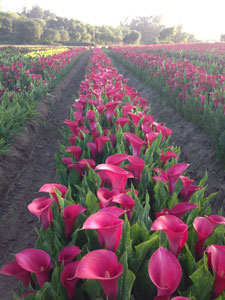1/31/2015
Putting the Ease in Growing Callas
Adrian Espinoza

Growing callas can be a fun experience. Callas are beautiful plants that come in an assortment of colors and sizes. They’ve gained much popularity due in large part to their extended shelf life and elegant flower form. On average, callas grown in pots take 10 to 12 weeks to finish and can be grown following easy steps during the different stages of their development.
Proper calla bulb size selection to accommodate finished pot size desired is the first step in ensuring properly grown calla pots. For the most part, we recommend one 20/24-cm calla bulb for a 6-in. pot and one 14/16-cm calla bulb for a 4-in. pot. However, very large specimen pots can be grown by planting multiple bulbs per pot.
Pictured: Hot Cherry from Coastal Callas in a Rancho Espinoza field.
The second step would be to ensure you source a true two-year, multi-eyed calla bulb (bulbs that are undisturbed for two seasons). Reliable supply is key in a successful crop. Starting with disease-free bulbs from a trusted source will ensure your success.
The third step is selecting a soil media that’s well-draining with a pH of 6.0 to 6.5. Examining your water moisture levels before watering is key, as over-watering can lead to disease infections.
The fourth step is planting. Calla bulbs should be planted about 1.5 to 2 in. below the soil level, with your multi-eyed tuber facing up. Callas develop roots from the top down. Ensuring the bulb is well-covered with soil will ensure a healthy growth cycle, but avoid planting too deep. Model growing conditions involves good air circulation, highest possible light and moderately high relative humidity.
The fifth stage is root and sprout development. During this stage a constant temperature of 68F (20C) is ideal across all varieties for 10 to 22 days, depending on sprout development. Once sprouts emerge from above the soil at 1.5 to 2 in., plant growth regulator is to be applied. We recommend a Bonzi drench. Do not apply Bonzi on dry plants. Different rates can be applied depended on the variety and pot size, and should be verified before application, as rates vary by variety vigor.
Fertilization can begin as soon as sprouts develop. We recommend weekly applications of 20-10-20 constant feed, including micros. Ensuring EC levels don’t exceed 2.5 is important.
The sixth stage is leaf unfurling and control. Once sprouts begin to unfurl, depending on the variety, this can start occurring day 22 through day 45. Maintaining temperatures of 70 to 75F (21 to 23C) during the day is ideal with night temperatures of 55 to 60F (12 to 15C). Cooler nights assist in keeping plants compact.
The seventh stage is flower development and height control. From day 46 to 70, depending on the variety, is when you’ll develop flower buds. Spacing your plants out during this stage is important, as this will assist in controlling your height and allow more light to your plants. Airflow is very important during this stage (as throughout the crop cycle), as this will prevent foliar and root diseases.
Pest management in controlling fungus gnats and shore flies is necessary in preventing bacteria spread. Aphids and thrips must be controlled, as they can cosmetically damage flowers and leaves, plus they can also spread viruses to healthy tubers. It’s very important to have an integrated pest management program in place to ensure potted calla plants grow healthy. Once callas start flowering, you can expect additional flowers to continue to grow.
Following these easy steps through the stages of their development will ensure high-quality production. Many growers have the perception that callas can be difficult to grow, but in following these recommendations, calla growing is easy. We hope you have as much fun as we do growing callas.
Please visit our website at
www.coastalcallas.com to view our large selection of varieties, along with more detailed cultural information and Bonzi recommendations per variety. Coastal Callas are exclusively distributed by Ball Horticultural Company. Contact your Ball Sales Representative for more details.
GT
Adrian Espinoza is owner and president of Coastal Callas in Salinas, California.